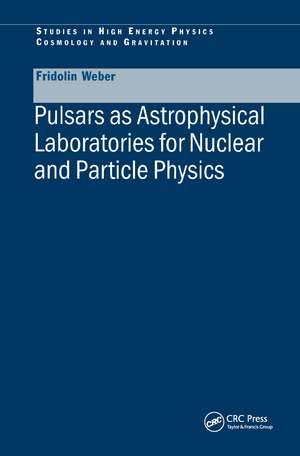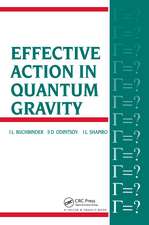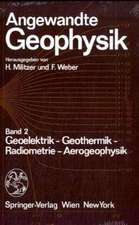Pulsars as Astrophysical Laboratories for Nuclear and Particle Physics: Series in High Energy Physics, Cosmology and Gravitation
Autor Fridolin Weberen Limba Engleză Hardback – mai 1999
These features combined with the tremendous recent progress in observational radio and x-ray astronomy make pulsars nearly ideal probes for a wide range of physical studies, complementing the quest of the behavior of superdense matter in terrestrial collider experiments. Written by an eminent author, Pulsars as Astrophysical Laboratories for Nuclear and Particle Physics gives a reliable account of the present status of such research, which naturally is to be performed at the interface between nuclear physics, particle physics, and Einstein's theory of relativity.
Preț: 694.27 lei
Preț vechi: 816.78 lei
-15% Nou
Puncte Express: 1041
Preț estimativ în valută:
132.97€ • 136.99$ • 111.38£
132.97€ • 136.99$ • 111.38£
Carte tipărită la comandă
Livrare economică 24 februarie-10 martie
Preluare comenzi: 021 569.72.76
Specificații
ISBN-13: 9780750303323
ISBN-10: 0750303328
Pagini: 696
Ilustrații: 1
Dimensiuni: 156 x 234 x 42 mm
Greutate: 1.27 kg
Ediția:1
Editura: CRC Press
Colecția CRC Press
Seria Series in High Energy Physics, Cosmology and Gravitation
Locul publicării:Boca Raton, United States
ISBN-10: 0750303328
Pagini: 696
Ilustrații: 1
Dimensiuni: 156 x 234 x 42 mm
Greutate: 1.27 kg
Ediția:1
Editura: CRC Press
Colecția CRC Press
Seria Series in High Energy Physics, Cosmology and Gravitation
Locul publicării:Boca Raton, United States
Public țintă
ProfessionalCuprins
Introduction. Overview of relativistic stars. Observed neutron star properties. Physics of neutron star matter. Relativistic field-theoretical description of neutron star matter. Spectral representation of two-point Green function. Dense matter in relativistic Hartree and Hartree-Fock. Quark-hadron phase transition. Ladder approximation in self-consistent baryon-antibaryon basis. Matrix elements of one-boson-exchange potentials. Partial-wave expansions. Dense matter in relativistic ladder approximation. Models for the equation of state. General relativity in a nutshell. Structure equations of non-rotating stars. Criteria for maximum rotation. Models of rotating neutron stars. Strage quark matter stars. Cooling of neutron and strange stars. Notation. Useful mathematical relationships. Hartree-Fock self-energies at zero temperature. Hartee-Fock self-energies at finite temperature. Helicity-state matrix elements of one-boson-exchange potential. Partial-wave expansion. Rotating stars in general relativity. Quark matter at finite temperature. Models of rotating relativistic neutron stars of selected masses. Equations of state in tabulated form. References.
Recenzii
"A remarkable reference work covering an enormous range of material from astrophysics to nuclear and particle physics in an interesting and accessible manner. This is a very important contribution to the literature."
-Anthony W. Thomas, University of Adelaide, Australia
-Anthony W. Thomas, University of Adelaide, Australia
Descriere
Written by an eminent author, Pulsars as Astrophysical Laboratories for Nuclear and Particle Physics discusses how pulsars are ideal probes for various physical studies, focusing on the interface between nuclear physics, particle physics, and Einstein's theory of relativity. It presents a reliable account of the progress in observational radio and x-ray astronomy. The book covers Hartree-Fock self-energies, partial-wave expansion, stars, and more "exotic" processes, including the formation of absolutely stable strange quark matter-a configuration of matter even more stable than the most stable atomic nucleus.
























